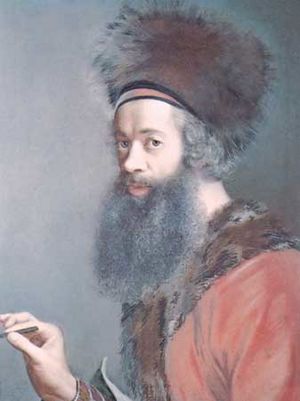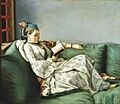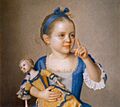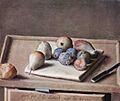Jean-Étienne Liotard facts for kids
Jean-Étienne Liotard (born December 22, 1702 – died June 12, 1789) was a famous Swiss painter. He was also an art expert and a dealer. Liotard is most famous for his beautiful portraits made with pastels. He is also known for the artworks he created during his time in Turkey.
Liotard was born and died in Geneva, Switzerland. His family were Huguenots, which means they were French Protestants. Even though he was from Geneva, he spent most of his life traveling. He worked in many big cities across Europe, like Rome, Istanbul, Paris, Vienna, and London. People in these cities really wanted him to paint their portraits.
Contents
Life of a Traveling Artist
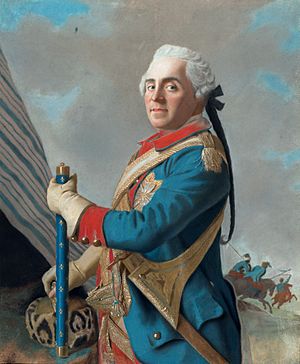
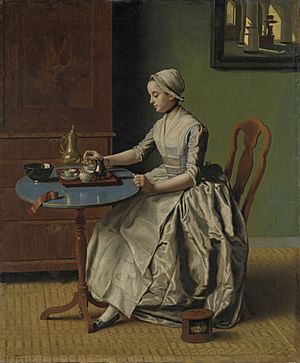
Jean-Étienne Liotard was born in Geneva. His parents were French Protestants who had to leave France after 1685. Young Jean-Étienne started learning art from teachers like Daniel Gardelle and Petitot. He became very good at copying their tiny enamel paintings and miniatures.
In 1725, he moved to Paris to continue his studies. His teachers there were Jean-Baptiste Massé and François Lemoyne. Because of Lemoyne's recommendation, Liotard traveled to Naples with an important person named Louis Philogène Brulart.
By 1735, Liotard was in Rome. There, he painted portraits of important people like Pope Clement XII and several cardinals. In 1738, he went to Constantinople (which is now Istanbul) with Lord Duncannon. He stayed and worked there for four years.
Liotard loved his time in Istanbul. He painted many pastel pictures showing scenes from Turkish homes. What's interesting is that even after he returned to Europe, he often wore Turkish clothes! At that time, European artists often showed people in Middle Eastern settings wearing local clothes. This was because modern European clothes were not seen as heroic or elegant in such paintings.
Many travelers, like Lord Byron, had their portraits painted in exotic Eastern clothes after their trips. Even people who had never left Europe, like Madame de Pompadour, did this. Lord Byron's poems were very popular. They helped introduce Europe to the exciting mix of Romanticism and exotic Eastern settings. This style became very popular in 19th-century art.
Because Liotard kept wearing his unusual Turkish clothes, people started calling him "the Turkish painter."
In 1742, he went to Vienna to paint portraits of the royal family. In 1745, he sold his famous painting La belle chocolatière to Francesco Algarotti.
Liotard continued to have important supporters. He returned to Paris and then visited England in 1753. In England, he painted Princess Augusta of Saxe-Gotha, who was the Princess of Wales. In 1756, he went to Holland. The next year, he married Marie Fargues, who was also from a Huguenot family. She wanted him to shave off his famous beard!
He painted more portraits in Vienna in 1762, including one of Marie Antoinette. In 1770, he was in Paris. He visited England again in 1772. For the next two years, his name appeared in the Royal Academy art shows. He returned to his hometown of Geneva in 1776. In 1781, Liotard published a book about painting called Traité des principes et des règles de la peinture. In his later years, he painted still lifes (pictures of objects) and landscapes. He passed away in Geneva in 1789.
Liotard's Artworks
Liotard was a very skilled artist who could do many different things. He is best known for his beautiful and delicate pastel drawings. Some lovely examples include La Liseuse, The Chocolate Girl, and La Belle Lyonnaise at the Dresden Gallery. Another famous one is Maria Frederike van Reede-Athlone at Seven at the J. Paul Getty Museum.
Besides pastels, he was also good at making enamels, copperplate engravings, and glass paintings. He even wrote a book about painting and was an expert at collecting paintings by old masters.
He sold many of the valuable paintings he had collected for high prices during his second visit to England. The museums in Amsterdam, Bern, and Geneva have many of his paintings and pastel drawings. You can find a picture of a seated Turk at the Victoria and Albert Museum. The British Museum has two of his drawings.
The Louvre museum has twenty-two of his drawings. It also has a portrait of Lieutenant General Hérault. There is also an oil painting of an English merchant and a friend dressed in Turkish clothes, called Monsieur Levett and Mademoiselle Helene Glavany in Turkish Costumes. A self-portrait of Liotard can be seen at the Uffizi Gallery in Florence. Since his son also married a Dutch girl, the Rijksmuseum inherited many of his important drawings and paintings.
One special thing about Liotard's portraits is that many of his subjects are smiling. At that time, people in portraits usually looked very serious. This happy mood in his paintings showed the ideas of the Enlightenment era, which inspired Liotard. Also, Liotard created art that celebrated science. For example, he painted a woman showing thanks to the doctor who saved her.
The Pastel Medium
Liotard was also known as "the painter of truth." He chose to use pastels because they helped him make his paintings look very natural and real. His works Apollo and Daphne and The Three Graces might be his oldest pastel pieces that still exist.
While Liotard mostly used oil paint in Paris, his career as a pastel artist really began in Italy. He knew about pastels from his younger days in Geneva, but it wasn't his main art form then. He was rejected by the Royal Academy of Painting in Paris for his historical oil paintings. This might have encouraged him to go back to pastels, a medium he was much better at.
In his book, Liotard talked about how important it was to make brushstrokes invisible. This helped to create a realistic copy of nature. It was much easier to hide brushstrokes with pastel than with oil paint. So, Liotard chose pastels because they could imitate nature so well. He believed this was the most important part of painting.
For the same reason, a writer named Diderot said that pastel was the best medium for portraits. This was in his book Dictionnaire Raisonné from 1751, when pastels were very popular.
Pastel colors are very dry, which makes them intense and bright. Liotard loved working with these vibrant colors. He wrote that "pastel painting is more beautiful than any other kind of painting" because of its "beauty, liveliness, freshness, and lightness." Liotard was known for pressing pastels very hard onto the paper. This created an extra shine and made the colors even more brilliant. This special technique and his desire for bright colors made his pastel works unique.
Support and Fixatives
Liotard often used vellum for his pastel artworks. Vellum is a smooth surface made from the skin of calves, goats, or lambs. He liked it because it kept the colors of the pastel very bright. He often prepared his vellum by mixing fish glue and wine with fine pumice dust.
In the 1700s, pastel artists often used colored paper as a base for their work. Thick blue paper was especially popular because it made the pastel colors look even brighter. Liotard also often used blue paper when he worked on paper.
Most pastels from the 1700s were not "fixed." Fixing means spraying a special liquid over the artwork to keep the powdery pigment from coming off. Pastel pigment is applied dry, so it can easily come off the surface. It is also sensitive to moisture and stains. This makes it harder to preserve pastel artworks over time.
Images for kids
-
Richard Pococke, 1738–39, oil on canvas
-
Portrait of a Turkish grand vizier, probably Hekimoğlu Ali Pasha, around 1738–1743, pastel on paper
-
The Chocolate Girl, 1743–1744
-
Count Francesco Algarotti, 1745, pastel on parchment
-
Empress Maria Theresia, 1747, enamel on copper
-
Marie Josèphe von Sachsen, 1749, pastel on vellum
-
Portrait of Frederick, Prince of Wales, 1754, pastel on vellum
-
Portrait of Princess Louisa of Great Britain, 1754
-
Still Life, Tea Set, around 1781–83, oil on canvas
See also
 In Spanish: Jean-Étienne Liotard para niños
In Spanish: Jean-Étienne Liotard para niños
- List of Orientalist artists
- Orientalism


